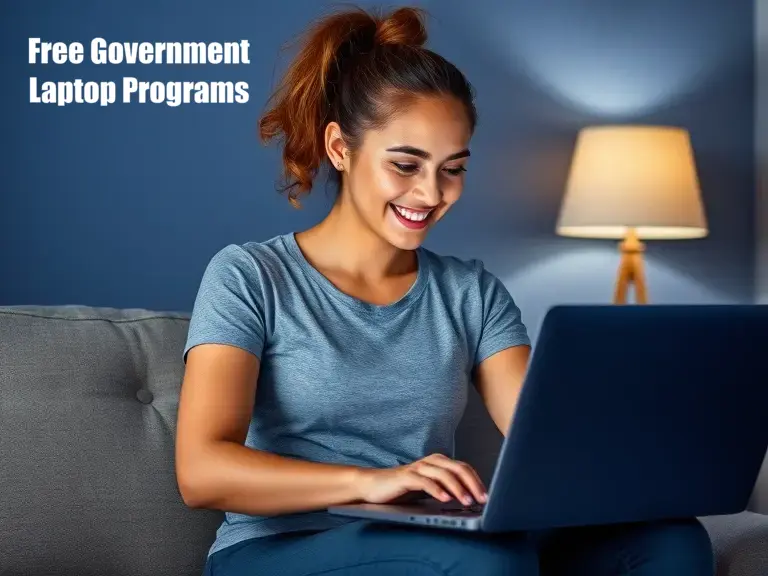Free Government Laptop
In an era where technology has become an indispensable part of our lives, access to laptops is no longer a luxury but a necessity. Around the globe, approximately 3.35 billion individuals rely on laptops for communication, education, work, and entertainment. However, not everyone can afford this essential tool. To address this issue, many governments have introduced initiatives to distribute free laptops, aiming to bridge the digital divide and ensure equitable access to technology.
These programs primarily target low-income families, students, seniors, and underserved communities. While undeniably beneficial, questions often arise regarding the sustainability of such programs, eligibility requirements, and their long-term impact on recipients. In this article, we’ll explore these government programs, dive deep into how they work, and provide actionable steps for you to secure a free laptop for yourself or your family.
How to Get a Free Laptop from the Government?

This guide will walk you through the steps to obtain a free government laptop, including an overview of the top programs like EBT (Electronic Benefits Transfer), Medicaid, Lifeline, and the Affordable Connectivity Program (ACP). From understanding eligibility requirements to completing application forms, this article has all the information you need.
What Is the Free Government Laptop Program?
State-run programs offering free laptops with tablets aim to assist individuals and families facing financial challenges. The main objective is to ensure equal access to modern technology for all.
Eligible recipients such as students, individuals residing in digitally underserved areas, or low-income families can receive laptops either free of charge or at a subsidized cost. These programs often go beyond merely providing devices, also offering services like:
- Technical Support
- Computer Literacy Training
- Access to Educational Resources
By addressing the technological needs of marginalized groups, these programs significantly improve educational outcomes, enhance computer literacy, and increase employment opportunities. However, challenges like limited funding, infrastructure issues, and lack of follow-up support remain significant barriers to long-term success.
Are Governments Actually Distributing Free Laptops?

Yes, many governments and non-profit organizations around the world are actively involved in distributing free laptops. Some top ranked initiatives include:
- One Laptop per Child (OLPC): A worldwide program offers low-cost laptops to children in underdeveloped regions, promoting equal opportunities for education through technology.
- U.S.-based Programs:
- ConnectHomeUSA: Designed to bridge the digital divide for residents in HUD-assisted housing.
- Digital Equity Initiative: Focuses on offering laptops at no or minimal cost to underprivileged communities across the United States.
- State-Level Programs: Certain states provide laptops at no cost to students in low-income households as part of wider educational assistance programs.
How Do Free Government Laptop Programs Work?
Government bodies or nonprofit groups usually oversee these programs. The process often involves the following steps:
- Eligibility Verification: Eligibility requires applicants to satisfy certain conditions, such as income limits or participation in programs like SNAP, Medicaid, or ACP.
- Application Process:
- Complete an online or physical application form.
- Provide necessary documents, including identification, income verification, or evidence of participation in government aid programs.
- Applicants might sometimes be required to participate in informational interviews.
- Distribution: Once approved, recipients either receive their laptops by mail or pick them up from designated distribution centers. The laptops usually come with essential software installed and may offer limited internet access to help recipients begin using them.
How to Get a Free Laptop: Exploring Your Option?

Securing a laptop depends on your requirements and eligibility, with multiple options available. Let’s explore these options in detail:
1. Through Government Programs
Initiatives such as EBT, Medicaid, and the Affordable Connectivity Program (ACP) provide free or low-cost laptops to promote digital accessibility. These programs cater to low-income families, students, and underserved populations.
2. Through Non-Profit Organizations
Many non-profits focus on refurbishing and distributing used laptops to those in need. Examples include:
- Human-I-T: Operating across 35 states, this organization provides refurbished electronics to low-income families.
- Computers with Causes: Distributes refurbished laptops nationwide to individuals in need, focusing on education and employment opportunities.
- PCs for People: PCs for People provides low-cost or free laptops to those participating in programs such as SNAP, Medicaid, or ACP.
3. Through Educational Institutions
Colleges, universities, and online schools often provide free laptops to enrolled students. Some institutions bundle laptop costs with tuition fees, while others offer scholarships specifically for technology access.
4. Through Retailers and Promotions
Retailers like Amazon occasionally partner with government programs or run promotional offers to distribute laptops. Keep an eye on giveaways, discounts, and rewards programs to increase your chances of obtaining one. If you are living in Australia, you can also apply for Free Centrelink Laptop Grant via Services Australia.
Top 5 Providers for Free Government Laptops

1. Human-I-T
- What They Do: Refurbish and redistribute donated electronics to low-income individuals and families.
- Eligibility: Requires proof of low-income status.
- Contact: 888-268-3921
2. One Laptop per Child (OLPC)
- What They Do: Provide laptops to children in underserved areas, focusing on education.
- Contact: +1 305-371-3755 | info@laptop.org
3. Computers with Causes
- What They Do: Donate refurbished laptops to individuals and communities in need.
- Eligibility: Requires proof of financial need or a clear educational/work-related purpose.
4. PCs for People
- What They Do: Provide free or low-cost laptops to those enrolled in programs like ACP or Medicaid.
- Locations: Operates in 17 U.S. cities, including St. Paul, Cleveland, and Atlanta.
5. Freecycle
- What They Do: A community-driven platform where members donate items they no longer need, including laptops.
- Eligibility: Varies by donor.
6. Free Government Wireless
- What They Do: Donate used and new laptops to eligible individuals and families.
- Eligibility: Requires proof of financial need or a clear educational/work-related purpose.
Eligibility Requirements for Free Government Laptops
To qualify for these programs, applicants must meet specific criteria. The most common requirements include:
- Financial Need Verification: Proof of low-income status (e.g., tax returns, pay stubs, or enrollment in government assistance programs like SNAP or Medicaid).
- Educational or Vocational Purpose: Demonstrate a need for the laptop to pursue education, employment, or skill-building opportunities.
- Household Composition: Priority may be given to households with dependents, individuals with disabilities, or seniors.
- Community Involvement: In some cases, volunteering or community engagement can strengthen your application.
Special Free Laptop Programs for Specific Groups
1. Students
Students often benefit the most from free laptop programs, as technology is critical for accessing educational resources and participating in online learning.
- Eligibility: Based on financial need or enrollment in specific colleges/universities.
- Notable Colleges Offering Free Laptops: Seton Hill University, St. John’s University, and Bethel University.
2. Seniors
Free laptops enable seniors to connect with loved ones, access medical services, and engage in virtual communities.
3. Veterans
Programs designed for veterans often emphasize job training, education, and healthcare access.
4. Disabled Individuals
Laptops featuring tools like screen readers or communication software can greatly enhance the lives of people with disabilities.
How the Affordable Connectivity Program (ACP) Can Help?
The ACP offers monetary support to low-income households, assisting with laptop purchases and internet service costs. Eligible individuals can receive up to $99 in vouchers toward purchasing a device and monthly discounts on broadband services.
Benefits of Free Laptop Programs
- Equal Access to Education and Job Opportunities: Ensures that all individuals, regardless of income, have access to vital resources.
- Empowerment of Underserved Communities: Supports underserved groups in building skills and engaging in the digital economy.
- Improved Social Connectivity: Allows seniors and families to maintain connections with loved ones and access essential services.
By leveraging these programs, you can secure the technology needed to improve your education, work opportunities, and overall quality of life. Stay informed about the latest initiatives, apply through the correct channels, and take advantage of these opportunities to bridge the digital divide.
